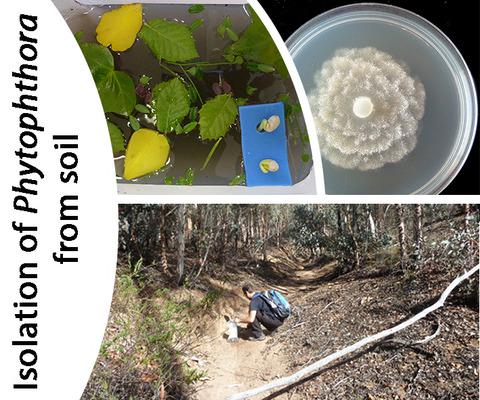当前位置:
X-MOL 学术
›
Plant Pathol.
›
论文详情
Our official English website, www.x-mol.net, welcomes your
feedback! (Note: you will need to create a separate account there.)
Towards a best practice methodology for the detection of Phytophthora species in soils
Plant Pathology ( IF 2.3 ) Pub Date : 2020-11-18 , DOI: 10.1111/ppa.13312 Treena I. Burgess 1 , Adrián López‐Villamor 2, 3 , Trudy Paap 1, 4 , Briony Williams 1, 5 , Rajah Belhaj 1 , Michael Crone 1 , William Dunstan 1 , Kay Howard 1 , Giles E. St. J. Hardy 1
Plant Pathology ( IF 2.3 ) Pub Date : 2020-11-18 , DOI: 10.1111/ppa.13312 Treena I. Burgess 1 , Adrián López‐Villamor 2, 3 , Trudy Paap 1, 4 , Briony Williams 1, 5 , Rajah Belhaj 1 , Michael Crone 1 , William Dunstan 1 , Kay Howard 1 , Giles E. St. J. Hardy 1
Affiliation

|
The genus Phytophthora contains species that are major pathogens worldwide, affecting a multitude of plant species across agriculture, horticulture, forestry, and natural ecosystems. Here, we concentrate on those species that are dispersed through soil and water, attacking the roots of the plants, causing them to rot and die. The intention of this study was to compare the soil baiting protocol developed by the Centre for Phytophthora Science and Management (CPSM) with two other baiting methods used in Australia. The aim was to demonstrate the effectiveness of each protocol for soil baiting Phytophthora species in different substrates. Three experiments were conducted: the first to test the sensitivity of each method to detect Phytophthora cinnamomi, the second to test the effect of substrate type (sand or loam), and the third to test the detection of species (P. cinnamomi, P. multivora, or P. pseudocryptogea). The specificity of different plant species baits was compared within and between the methods. Substrate type influenced isolation in all methods; however, the CPSM method was superior regardless of substrate, albeit slower than one of the other methods for one substrate. Comparing bait species between the three methods, Quercus ilex was the most attractive bait for P. cinnamomi, particularly in the CPSM method. The choice of protocol affected the isolation associated with each bait type. Overall, the multiple bait system used by CPSM was shown to provide the most sensitive and reliable detection of Phytophthora species from soil samples.
中文翻译:

迈向检测土壤中疫霉属物种的最佳实践方法
疫霉属包含的物种是世界范围内的主要病原体,影响农业、园艺、林业和自然生态系统中的多种植物物种。在这里,我们专注于那些分散在土壤和水中的物种,它们攻击植物的根部,导致它们腐烂和死亡。本研究的目的是将疫霉属科学与管理中心 (CPSM) 开发的土壤诱饵方案与澳大利亚使用的其他两种诱饵方法进行比较。目的是证明每种方案在不同基质中土壤诱饵 Phytophthora 物种的有效性。进行了三个实验:第一次测试每种方法检测肉桂疫霉的灵敏度,第二次测试基质类型(沙或壤土)的影响,第三个用于测试物种的检测(P. cinnamomi、P. multivora 或 P.pseudocryptogea)。在这些方法内和方法之间比较了不同植物物种诱饵的特异性。基材类型影响所有方法中的隔离;然而,CPSM 方法无论基材如何都更优越,尽管比一种基材的其他方法慢。比较三种方法之间的诱饵种类,冬青栎是最吸引肉桂的诱饵,尤其是在 CPSM 方法中。协议的选择影响了与每种诱饵类型相关的隔离。总体而言,CPSM 使用的多诱饵系统被证明可以最灵敏、最可靠地检测土壤样品中的疫霉属物种。在这些方法内和方法之间比较了不同植物物种诱饵的特异性。基材类型影响所有方法中的隔离;然而,CPSM 方法无论基材如何都更优越,尽管比一种基材的其他方法慢。比较三种方法之间的诱饵种类,冬青栎是最吸引肉桂的诱饵,尤其是在 CPSM 方法中。协议的选择影响了与每种诱饵类型相关的隔离。总体而言,CPSM 使用的多诱饵系统被证明可以最灵敏、最可靠地检测土壤样品中的疫霉属物种。在这些方法内和方法之间比较了不同植物物种诱饵的特异性。基材类型影响所有方法中的隔离;然而,CPSM 方法无论基材如何都更优越,尽管比一种基材的其他方法慢。比较三种方法之间的诱饵种类,冬青栎是最吸引肉桂的诱饵,尤其是在 CPSM 方法中。协议的选择影响了与每种诱饵类型相关的隔离。总体而言,CPSM 使用的多诱饵系统被证明可以最灵敏、最可靠地检测土壤样品中的疫霉属物种。尽管比一种基材的其他方法慢。比较三种方法之间的诱饵种类,冬青栎是最吸引肉桂的诱饵,尤其是在 CPSM 方法中。协议的选择影响了与每种诱饵类型相关的隔离。总体而言,CPSM 使用的多诱饵系统被证明可以最灵敏、最可靠地检测土壤样品中的疫霉属物种。尽管比一种基材的其他方法慢。比较三种方法之间的诱饵种类,冬青栎是最吸引肉桂的诱饵,尤其是在 CPSM 方法中。协议的选择影响了与每种诱饵类型相关的隔离。总体而言,CPSM 使用的多诱饵系统被证明可以最灵敏、最可靠地检测土壤样品中的疫霉属物种。
更新日期:2020-11-18
中文翻译:

迈向检测土壤中疫霉属物种的最佳实践方法
疫霉属包含的物种是世界范围内的主要病原体,影响农业、园艺、林业和自然生态系统中的多种植物物种。在这里,我们专注于那些分散在土壤和水中的物种,它们攻击植物的根部,导致它们腐烂和死亡。本研究的目的是将疫霉属科学与管理中心 (CPSM) 开发的土壤诱饵方案与澳大利亚使用的其他两种诱饵方法进行比较。目的是证明每种方案在不同基质中土壤诱饵 Phytophthora 物种的有效性。进行了三个实验:第一次测试每种方法检测肉桂疫霉的灵敏度,第二次测试基质类型(沙或壤土)的影响,第三个用于测试物种的检测(P. cinnamomi、P. multivora 或 P.pseudocryptogea)。在这些方法内和方法之间比较了不同植物物种诱饵的特异性。基材类型影响所有方法中的隔离;然而,CPSM 方法无论基材如何都更优越,尽管比一种基材的其他方法慢。比较三种方法之间的诱饵种类,冬青栎是最吸引肉桂的诱饵,尤其是在 CPSM 方法中。协议的选择影响了与每种诱饵类型相关的隔离。总体而言,CPSM 使用的多诱饵系统被证明可以最灵敏、最可靠地检测土壤样品中的疫霉属物种。在这些方法内和方法之间比较了不同植物物种诱饵的特异性。基材类型影响所有方法中的隔离;然而,CPSM 方法无论基材如何都更优越,尽管比一种基材的其他方法慢。比较三种方法之间的诱饵种类,冬青栎是最吸引肉桂的诱饵,尤其是在 CPSM 方法中。协议的选择影响了与每种诱饵类型相关的隔离。总体而言,CPSM 使用的多诱饵系统被证明可以最灵敏、最可靠地检测土壤样品中的疫霉属物种。在这些方法内和方法之间比较了不同植物物种诱饵的特异性。基材类型影响所有方法中的隔离;然而,CPSM 方法无论基材如何都更优越,尽管比一种基材的其他方法慢。比较三种方法之间的诱饵种类,冬青栎是最吸引肉桂的诱饵,尤其是在 CPSM 方法中。协议的选择影响了与每种诱饵类型相关的隔离。总体而言,CPSM 使用的多诱饵系统被证明可以最灵敏、最可靠地检测土壤样品中的疫霉属物种。尽管比一种基材的其他方法慢。比较三种方法之间的诱饵种类,冬青栎是最吸引肉桂的诱饵,尤其是在 CPSM 方法中。协议的选择影响了与每种诱饵类型相关的隔离。总体而言,CPSM 使用的多诱饵系统被证明可以最灵敏、最可靠地检测土壤样品中的疫霉属物种。尽管比一种基材的其他方法慢。比较三种方法之间的诱饵种类,冬青栎是最吸引肉桂的诱饵,尤其是在 CPSM 方法中。协议的选择影响了与每种诱饵类型相关的隔离。总体而言,CPSM 使用的多诱饵系统被证明可以最灵敏、最可靠地检测土壤样品中的疫霉属物种。











































 京公网安备 11010802027423号
京公网安备 11010802027423号